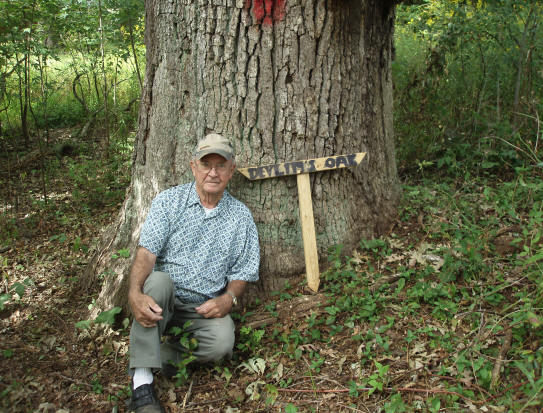|
The Mighty White Oak
Bill Devlin
Adams County Master Gardener
I was recently walking my dogs in the area just north of Lake Kay, in Carroll Valley, and came upon a very large white oak. The Fairfield Area School District recently developed some property adjacent to Northern Pike trail, adding two
athletic fields, and then expanded an access trail through some woods for use by their cross country runners. This was the second biggest oak tree I have ever seen, and the biggest I have seen in Pennsylvania. The biggest of course was the famous Wye oak on the eastern
shore of Maryland on the much traveled route from the Chesapeake Bay Bridge to Ocean City and Rehoboth Beach, Delaware. Alas, it expired in a storm in 2002, at an estimated age of 540 years and a circumference of 31 feet.

Our Pennsylvania tree has a circumference of 15 feet, and given the more favorable growing conditions on the eastern shore, I would estimate our tree’s age in the order of 350 years. In other words, when the illustrious William Penn took
title to our local lands in 1682, if the tree wasn’t growing here then, its parent tree certainly was.
To further my curiosity, the tree was dropping acorns at a very heavy rate so naturally I collected some every time I passed by. Then I began hitting the internet to learn more, and placed the acorns in my warm sunroom to dry prior to
stratifying the nuts. I first tried to find out how to estimate the age of the tree by its size and the literature. The literature was not particularly helpful, giving me the answer to the question of growth rate as "Slow". However the term "frost free days" used in
horticultural literature came to mind and I compared Wye Mills, Maryland to Gettysburg and found them to be 200 and 175 days respectively thus somewhat supporting my age estimate.
While the white oak is a slow grower, to my way of thinking, it’s a far superior tree to the fast growing ‘pin oak’ that’s frequently seen growing nowadays. The pin oaks will mature and die in a father – son – grandson life span, and the
white oak will last a dozen lifetimes. In other words, I plant my favorite pecan tree for my children and grandchildren, while I would plant a white oak tree for my grandchildren’s grandchildren, and their grandchildren. A quick search of the internet reveals these quotes
from Robert Rogers:
"White oak (Quercus alba) is an outstanding tree among all trees and is widespread across eastern North America.... Its high-grade wood is useful for many things, an important one being staves for barrels, hence the name stave oak. The
acorns are an important food for many kinds of wildlife."
"Seed Production and Dissemination: White oak can produce seeds prolifically, but good acorn crops are irregular and occur only every 4 to 10 years. Sometimes several years may pass without a crop…. This great variation in acorn production
exists not only among isolated stands of oaks but also among individual trees within stands and from year to year."
For those who don’t feel up to hiking in the woods to see the tree I am referring to near Carroll Valley, you can easily see large white oaks growing on the south side of Saint Mary’s Cemetery on Route 116 near Fairfield. These are not as
large as the one referred to earlier, but nevertheless they are formidable.
My plan was to grow seedlings from some of the acorns I collected. However, as the drying process developed I was greeted by the emergence of weevils (Conotrachelus, I believe). I photographed one to document the situation. The question is,
does this weevil destroy the acorn, or just damage it without killing the reproductive portion? Since the heat of my sun room sped up its emergence, I am hoping some of these acorns will still be viable. As with my pecan articles, I will donate white oak seedlings, if they
survive, to those who may want them. I anticipate having pecan seedlings next year also. Please email me at Devlinw1@aol.com and I will place you on the waiting list.
Read other articles about trees
|